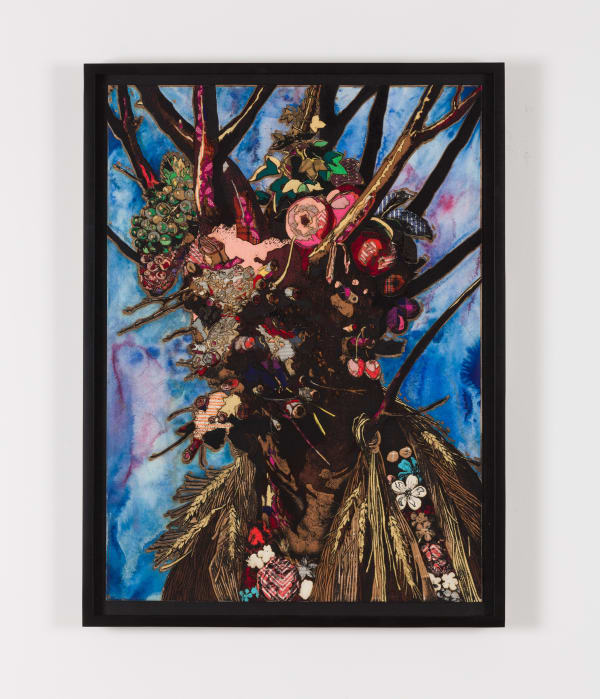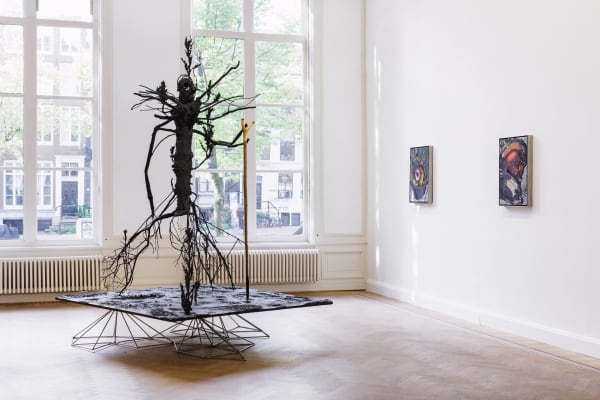Matthew Day Jackson: Pareidolia
GRIMM is proud to announce Pareidolia, a new solo exhibition by Matthew Day Jackson (1974, US) in Amsterdam.
The core of Pareidolia – the tendency to interpret random images, or patterns of light and shadow as faces- is finding a reflection of ourselves in our natural environment. For Matthew Day Jackson our relationship to our natural surroundings is akin to the separation of conjoined twins at birth who can no longer understand each other, are incapable of communicating, or who no longer care to try. Pareidolia here refers less to a human (dis)connectedness, but rather emphasizes a misunderstanding of what is visually perceived, undermining the fact that we are part of our natural environment.
In this new series of mixed media paintings Jackson references Giuseppe Arcimboldo (1527-1593), the Italian master of Mannerism, best known for his imaginative heads made entirely of fruits, vegetables, flowers and other objects. To Jackson, these portraits are an exuberant expression of nature’s bounty and a visual manifestation of power, wealth and decay. Major discoveries throughout the past two centuries have been motivated by political expansion and the accumulation of scientific knowledge – in his recent series of still life paintings, which are based on Dutch Golden Age paintings by Jan Brueghel the Elder (1568-1625) and in this new series, the artist reflects on how the power gained through this process has come at the expense of the environment. Jackson’s paintings are entirely composed of Formica, lead, plywood and epoxy. Artificial and manufactured materials such as these, carry meaning as a meditation on the domestic environment, aspiration, class and impermanence, in addition to having a personal resonance for Jackson; they are imbued with memories from his past and the artist’s own ‘American experience’.
A large figure made of direct cast branches, sticks and found objects is presented among the new paintings. This sculpture can be divided into three distinct elements: the figure, the rugged surface which it traverses and the base. The figure is a palimpsest of casts of several different trees and Scottish thistle. For Jackson, figuration is a meditation on the human form and a statement that our sense of humanity and the form of the body is not fixed, while the presentation of the figure speaks to the way we are constantly adapting to others and the environment. The incorporation of the Scottish thistle – which is considered an invasive species- folds in yet another layer of meaning regarding the origin of living things, and their existence outside of their supposed “home”, reflecting broader attitudes on race, class and gender. The sculpture is supported by a walking stick which is generally considered a tool for the infirm, however his intention here is quite the opposite- instead the staff serves to highlight that this terrain is challenging.
Supporting the figure is the irregular surface of a platform, a conglomeration of relief maps of national parks in the United States. In recent years many of these parks have come under threat of despoilment by the current administration. The desire to open these areas to private industry for ranching, drilling or mining is exemplary of the ideology of Manifest Destiny; Jackson proposes that this remains the foundation and binding narrative of the United States. The application of this ideology extends beyond the U.S. to planet earth, the moon and all spaces in between. According to this principle, the natural world is not only proof of a divine creator, but also a possession divined to us to exploit. At the base, the sculpture is supported by an abstraction of Buckminster Fuller’s (1895 –1983) Dymaxion map of the world, a three-dimensional world map which can be unfolded and flattened to two dimensions. Fuller created this map as a pedagogical tool in order to show earth’s land mass is connected and to demonstrate how energy can be distributed and shared creating what he called “four billion billionaires”. This concept of connectivity has been at the core of Jackson’s work since the beginning. Jackson’s seemingly incongruous use of forms and images is a reminder of the fact that we are all connected to each other and to our environment. The works reflect on the artist’s long standing idea that our evolution is not only found within the slow adaptation of flesh and bone through time, but also in the materials we use to express our humanity over time, the evolving process of the creation of society, and the performance of culture.
Opening: Thursday October 10, 6-8 pm, GRIMM Keizersgracht 241
















